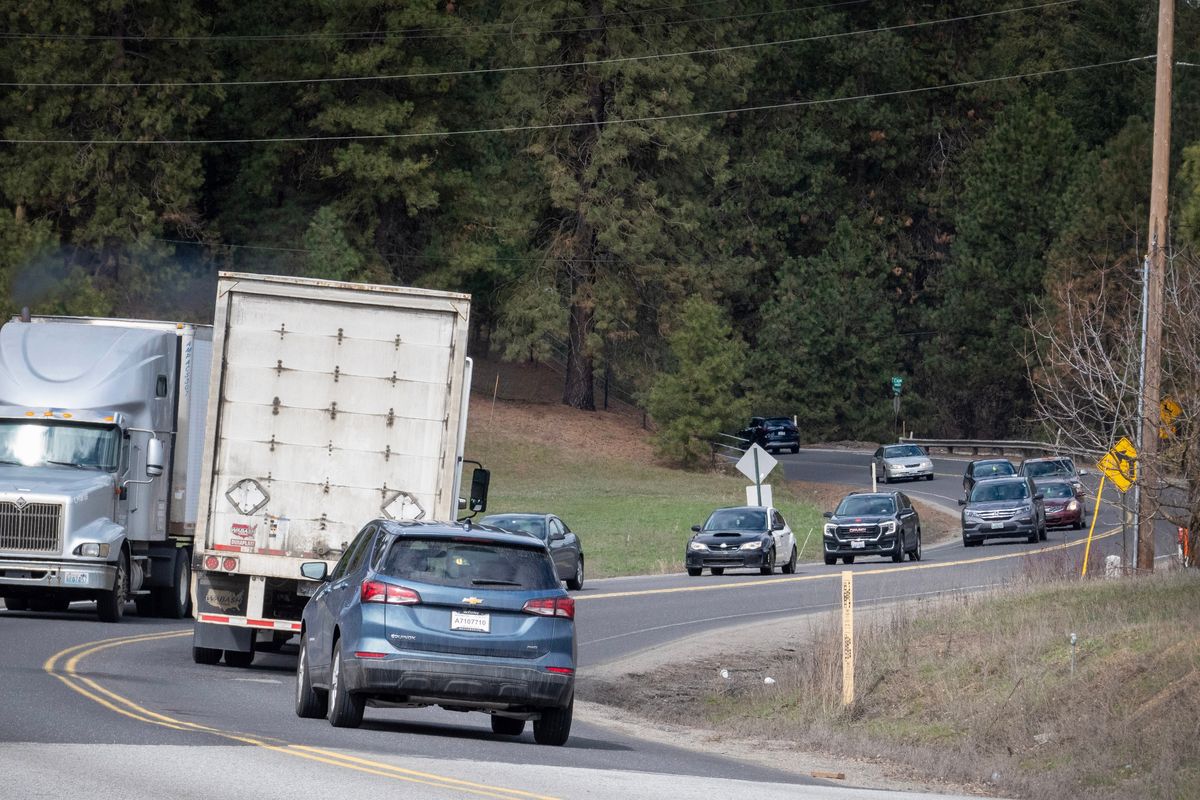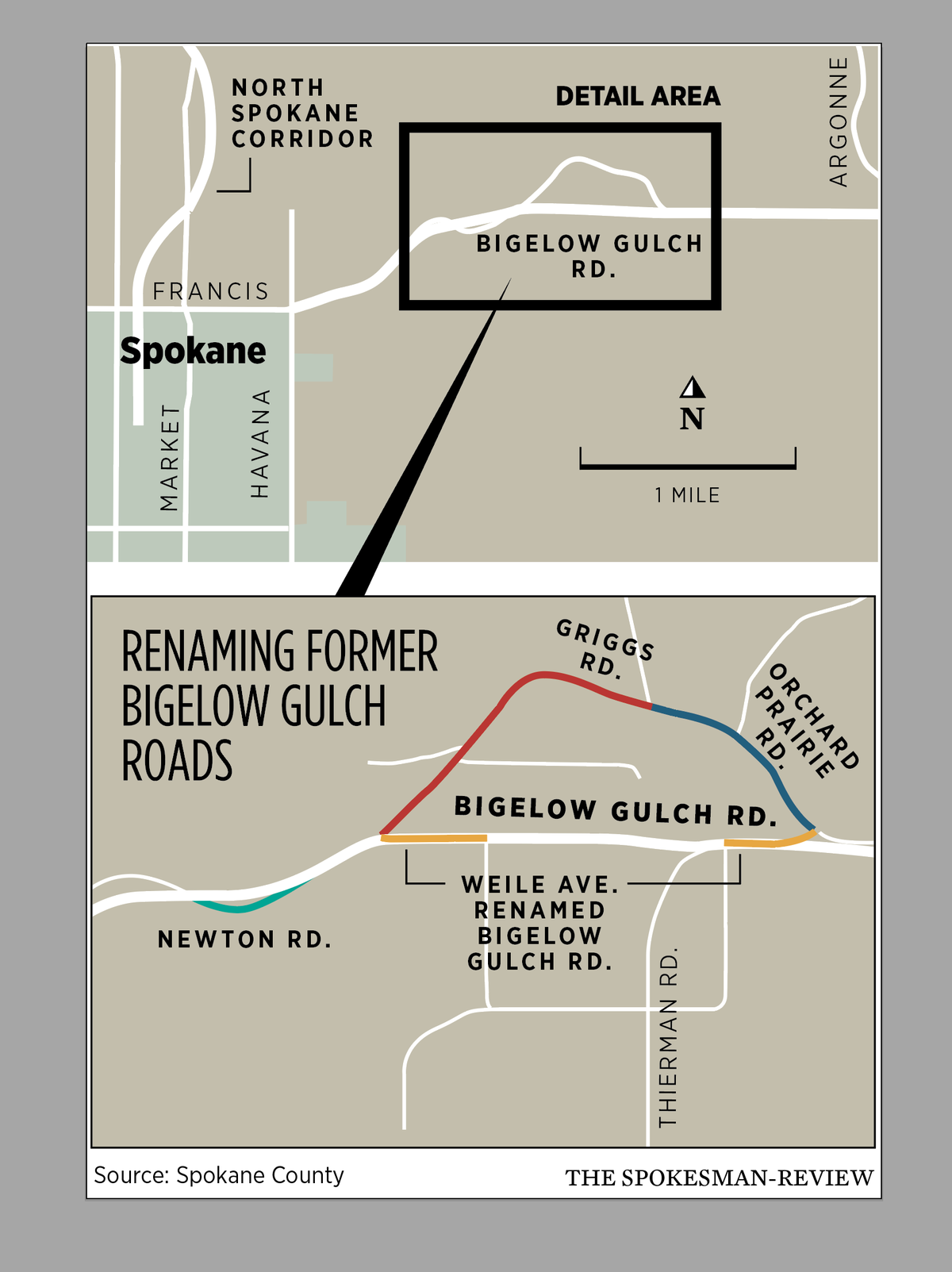Getting There: Who is Clarence Griggs and why is part of Bigelow Gulch Road being renamed for him?
Construction on Bigelow Gulch Road, winding just west of Weile Road from Hillyard and the intersection with Argonne Road, is wrapping up soon. (JESSE TINSLEY/THE SPOKESMAN-REVIEW)
The Spokane County Commissioners on Tuesday approved a slate of new names for the roads surrounding the Bigelow Urban Connector Project, including one name that honors a veteran of two world wars. But those changes didn’t quite satiate concerns aired weeks ago by nearby residents.
The county spent the summer blasting through a hillside to carve a straighter alignment for Bigelow Gulch Road, which should open next month. The work signals the end of a decadeslong project aimed to address safety concerns and increased traffic volumes, and necessitated the renaming of old portions of Bigelow Gulch no longer part of the new alignment.
The decision on what those new names would be was postponed two weeks ago after Orchard Prairie residents voiced their concerns about the options the commissioners were considering. While some of those concerns were alleviated, some residents still take issue with what was approved Tuesday.
The commissioners voted unanimously to rename the eastern bend of the old roadway into Orchard Prairie Road, which would extend the existing roadway to the intersection with the newly built Bigelow Gulch. The western portion of the old roadway will be Griggs Road, in place of the highly criticized “Lancer Road” that was first proposed for that portion.
The final name change involves a small section of Bigelow Gulch just west of the present-day intersection with Weile Avenue, where county officials elected to stick with the name Newton Road.
Those in attendance supported the commissioners’ decision not to use “Lancer,” which appeared to be the proposal neighbors took issue with most. Its replacement – “Griggs Road” – didn’t quite land either, despite having historical significance for the area and the county at large.
Karen Sprague, one of the residents who aired concerns a few weeks ago, said she was happy to see the name Orchard Prairie Road extended due to the significance of that name to the area. That’s the area’s name, and one of the longest continually operating schools in the state is Orchard Prairie Elementary School, which sits along the road with the same namesake.
“I’m very pleased with that,” Sprague said. “Griggs Road doesn’t strike a loving response from me.”
County Commissioner Josh Kerns brought the name Griggs forward after the suggestion was passed along to him by Spokane City Councilman Michael Cathcart.
The two conservatives were discussing the renaming process one day, Cathcart put some thought into it, and pulled the name from a 2018 article in The Spokesman-Review detailing the Bigelow Gulch project.
Griggs is the surname of the county engineer who helped transform Bigelow Gulch into the thoroughfare it is today. In 1937, he secured around $378,000 in New Deal-era federal funding to pave more than 80 miles of county roads, including Bigelow Gulch, as The Spokesman-Review reported.
“I think it’s a good compromise,” Kerns said. “Again, there’s connection to the road itself, not as strong of a connection to the community, and I get that.”
He added that the name changes needed to occur relatively quickly with the roadway expected to open soon, something County Commissioner Chris Jordan also noted when voicing his support of the changes.
“Mr. Griggs was integral to the history of creating the old Bigelow Gulch road during that New Era,” Jordan said. “So it’s a significant improvement from where we were, an elegant compromise, and I’m happy to support it.”
Griggs: Army vet, engineer, councilman
Newspaper records shed a little more light onto Clarence Francis Griggs’ stint with the county.
He’s credited with designing and establishing “the first unit” of Geiger Field, which served as a military training base during World War II, before the Spokane International Airport was established on the same ground.
He also designed the first iteration of the Francis Avenue bridge over the railroad tracks in Hillyard, and did extensive work on the Wandermere Golf Course. During the winters of 1940 and 1941, Griggs oversaw the plowing of county roads receiving record snowfalls and the rebuilding of those same roads when floods washed them out the next spring.
As the war ramped up overseas, Griggs leaned into his military background and took on the lead role for the county’s defense council, which sought to train residents and prepare the region for the possibility of an attack.
Still, the county engineer must have felt he could do more, as he re-enlisted in the army in August 1943. The county commission granted Griggs a leave of absence from his position so the World War I veteran could re-enlist as a captain to fight in the second World War.
“Commissioner John T. Little, seconded by Commissioners (Wylie) Brown and (C.M.) Lockwood, expressed the regret of the board at the departure of Captain Griggs but applauded him for his desire to have an active part in the war effort,” a 1943 Spokane Daily Chronicle article reads.
The commissioners went on to thank Griggs for his work over the years, saying he was just as valuable as a road engineer as he was in meetings with legislators. Little credited him with persuading state lawmakers to allocate more gas tax proceeds to the county.
“He has done a good job here, and his departure is the county’s loss and the army’s gain,” Little told the Chronicle.
Griggs never returned to his role with the county.
While stationed in Maryland as an Army engineer in 1945, Little sent a telegraph to Griggs to see what his plans were after the war. Griggs replied his plans were “indefinite,” according to the Spokane Daily Chronicle at the time.
Unsure of what exactly that response meant, the county commissioners elected to fill Griggs’ position. The commissioners said if Griggs did return, they would make him an assistant engineer and allow him to keep his former salary of $400 a month until he found another job.
“We did not feel, under the circumstances, it was necessary to hold Griggs’ job open for him,” Brown told the newspaper. “He was not inducted. He volunteered and was commissioned.”
Griggs landed in Pasco when he got out of the war, where he started his own engineering and surveying company C. F. Griggs and Associates. In that capacity, he helped develop the Port of Pasco, and neighboring Tri-Cities Airport, according to his obituary.
Griggs wasn’t quite done with local government, however. He served on the Pasco City Council for two years, until his death in 1966. He was 68, and left behind his wife Beryl Griggs, five sons, a daughter and 11 grandchildren.
Attempts to reach his descendants were not successful ahead of publication.
“There’s certainly some great history,” Public Works Director Kyle Twohig said. “I’m certainly proud to have some public works-related suggestion for this renaming, and to have our former county engineer’s name out here on this whole corridor.”

